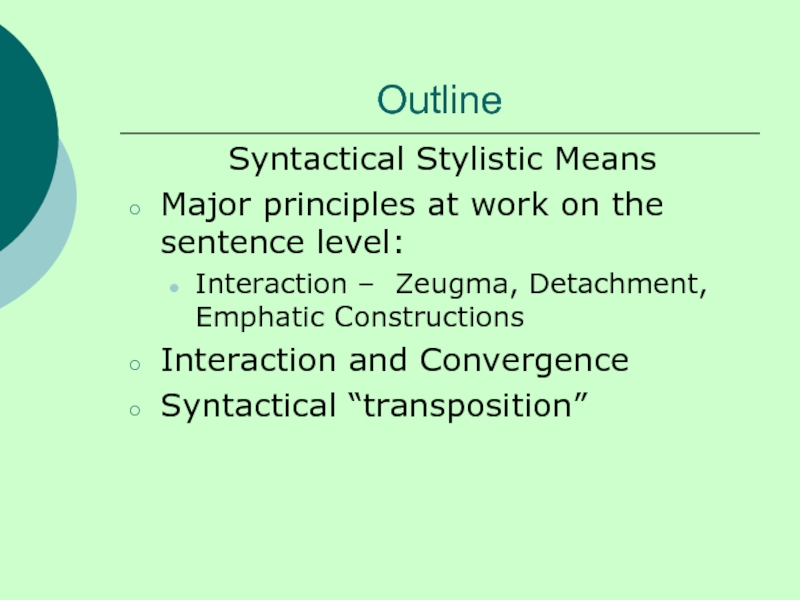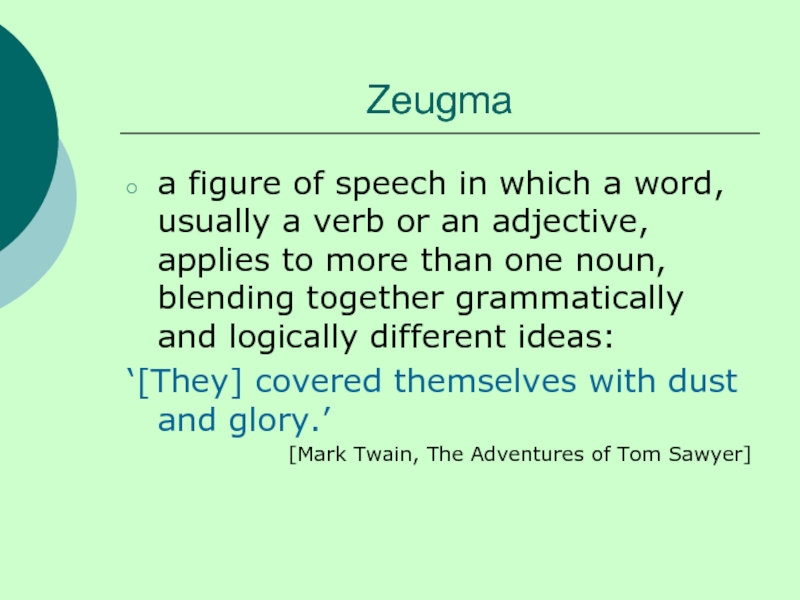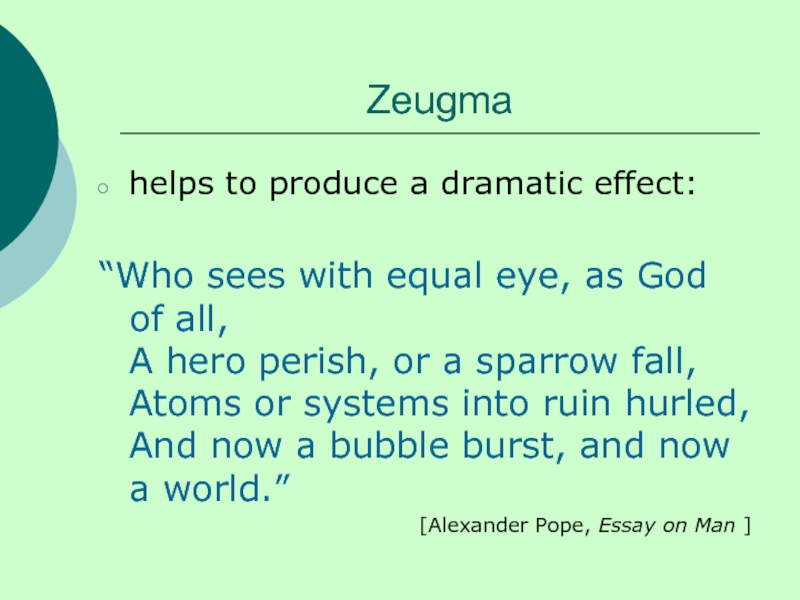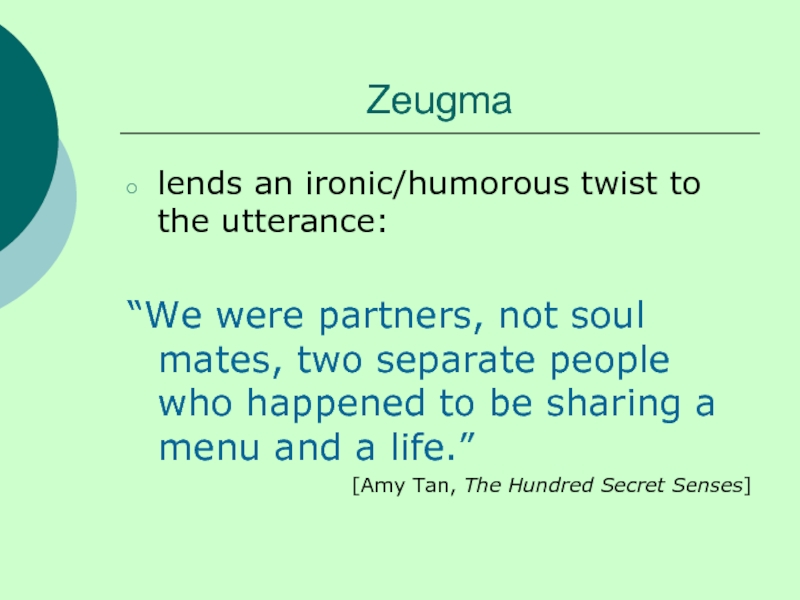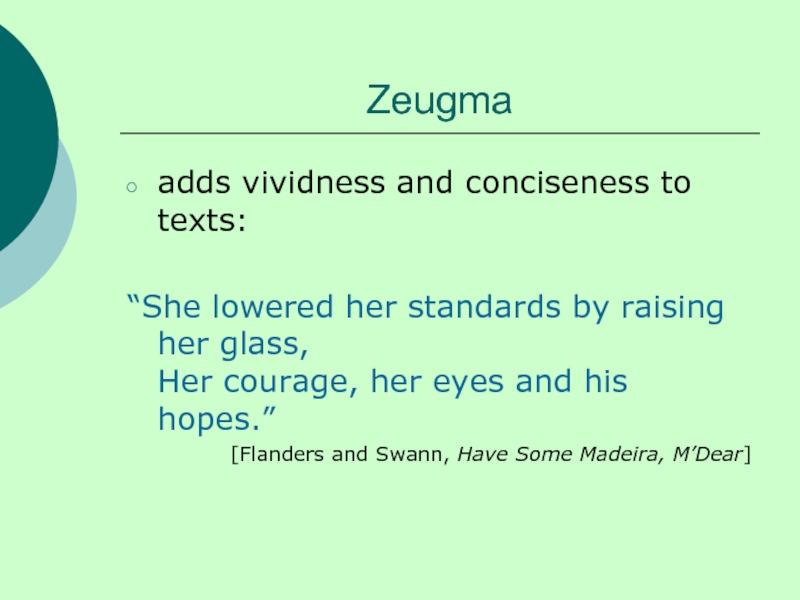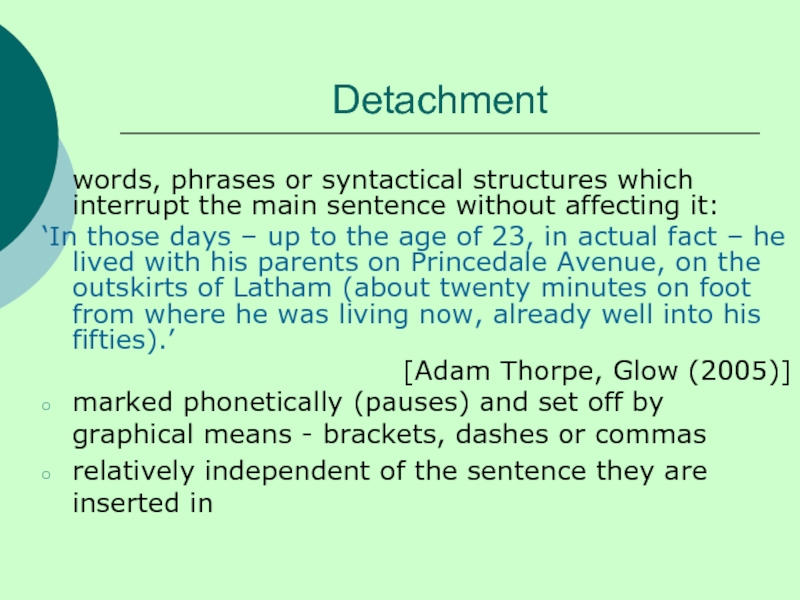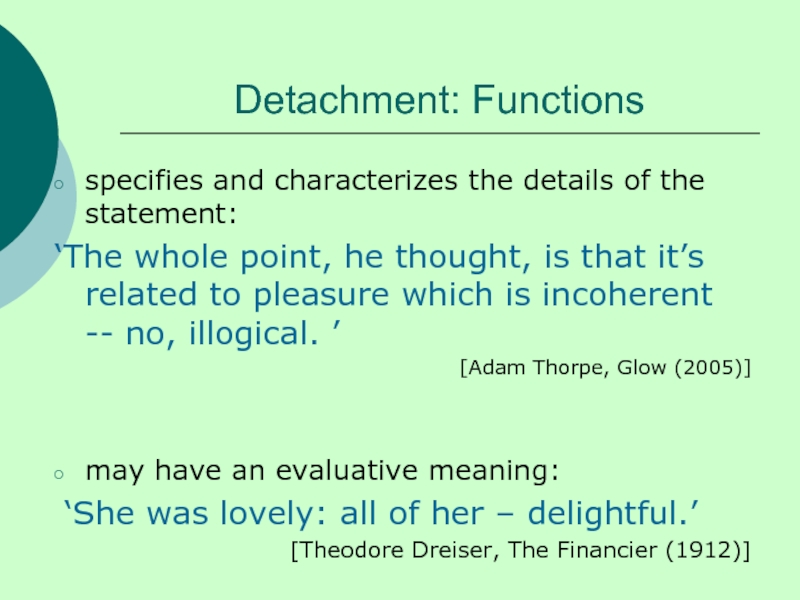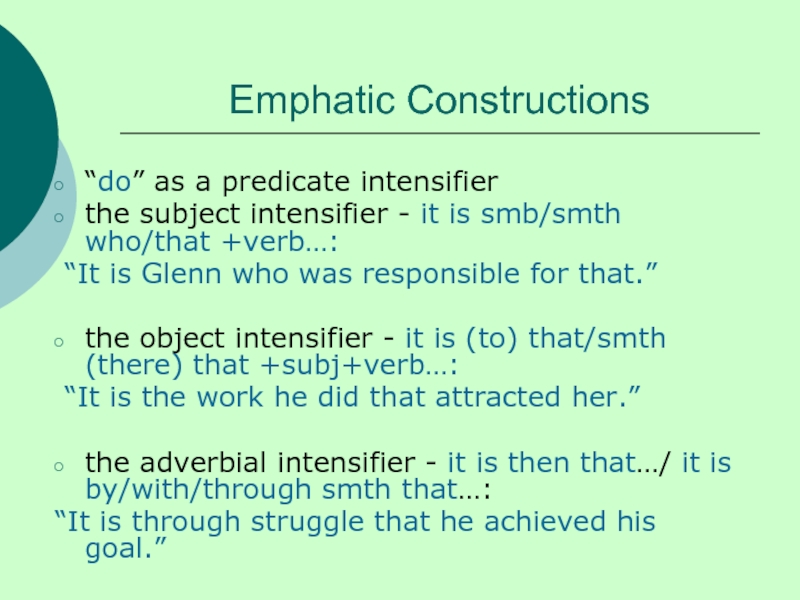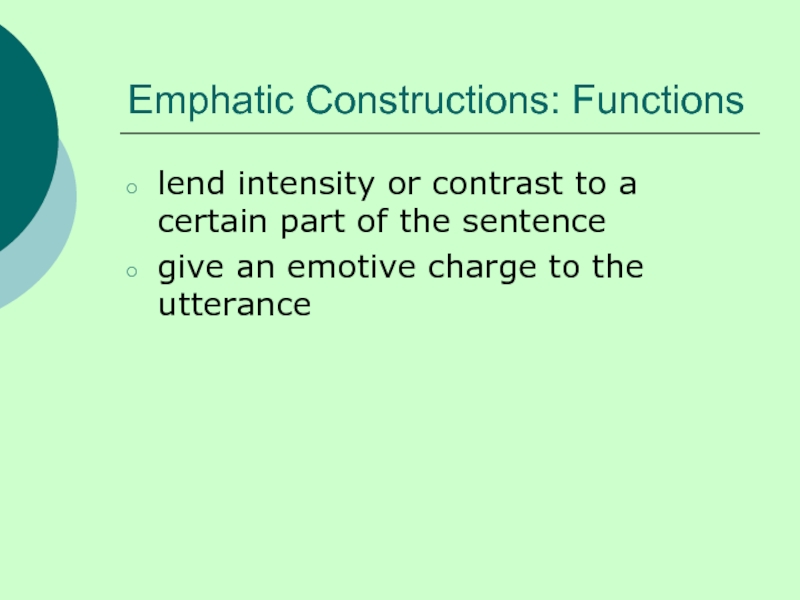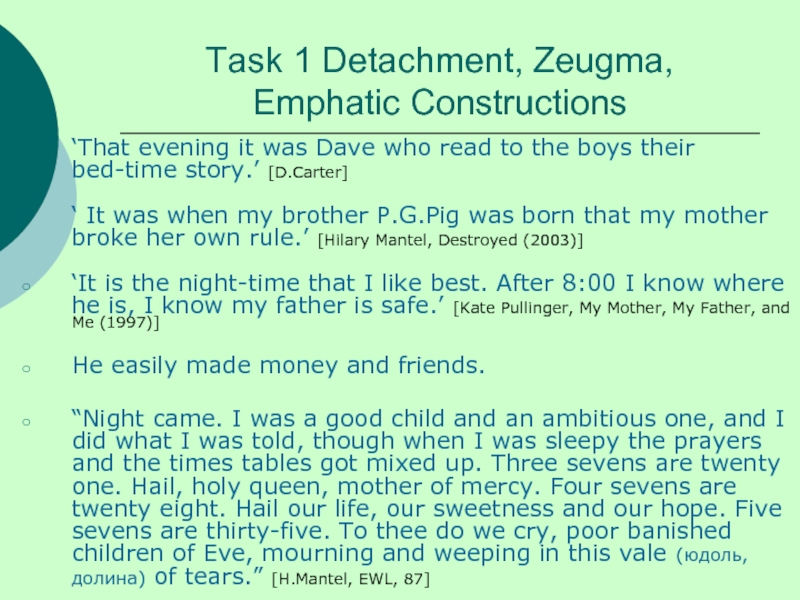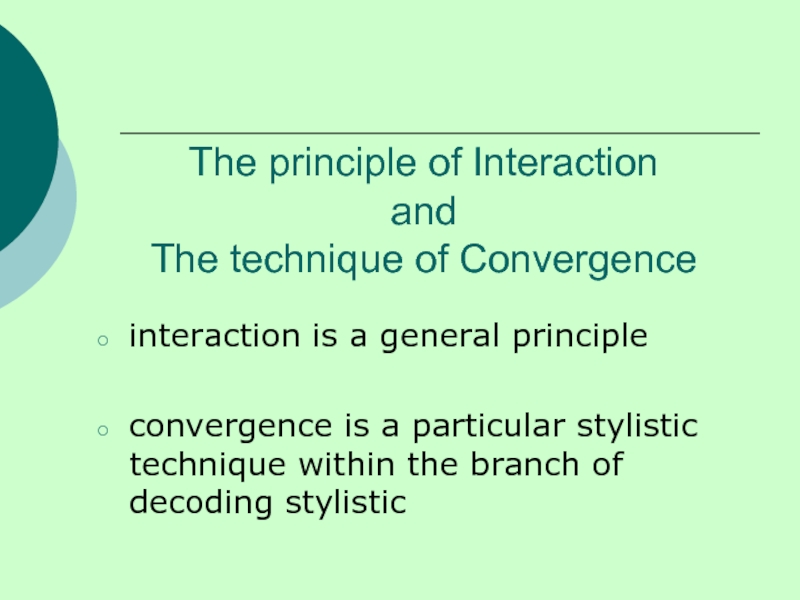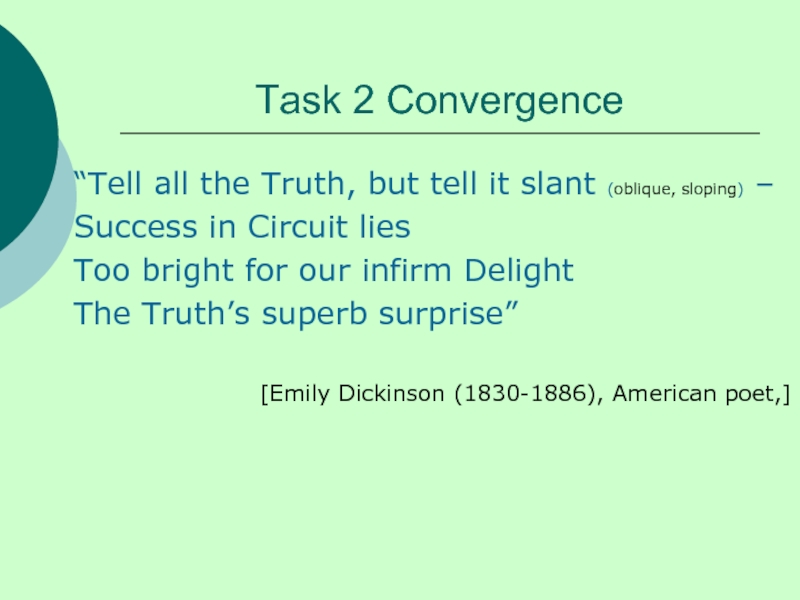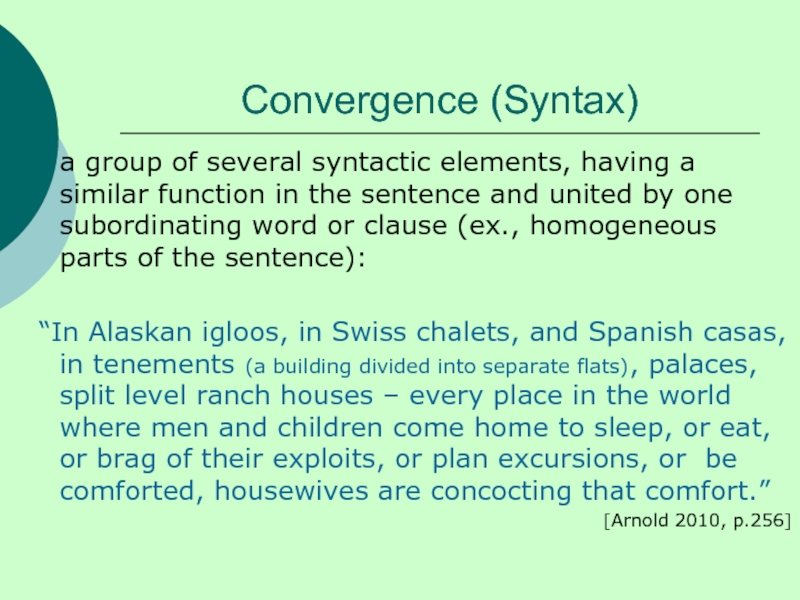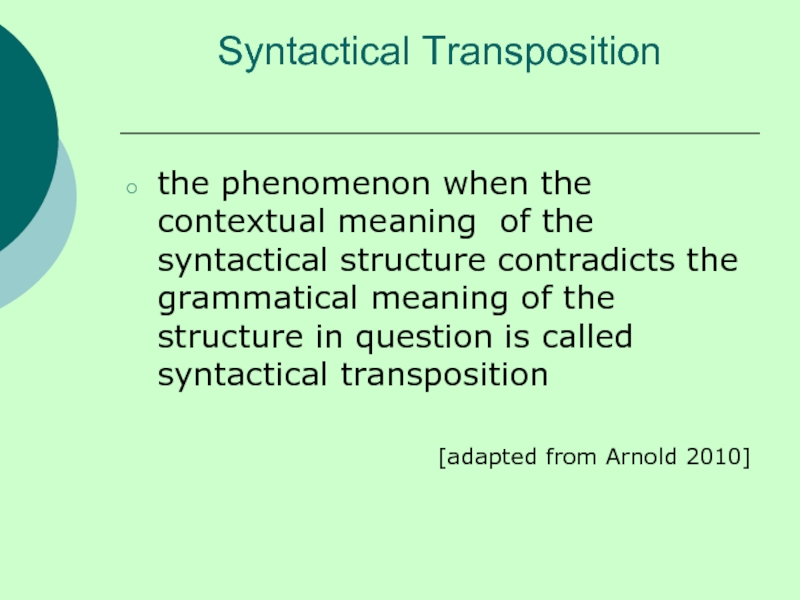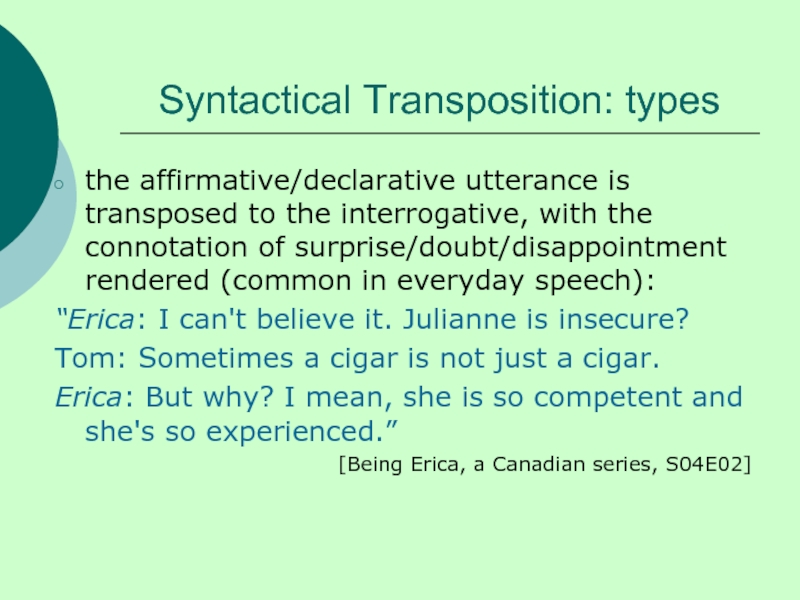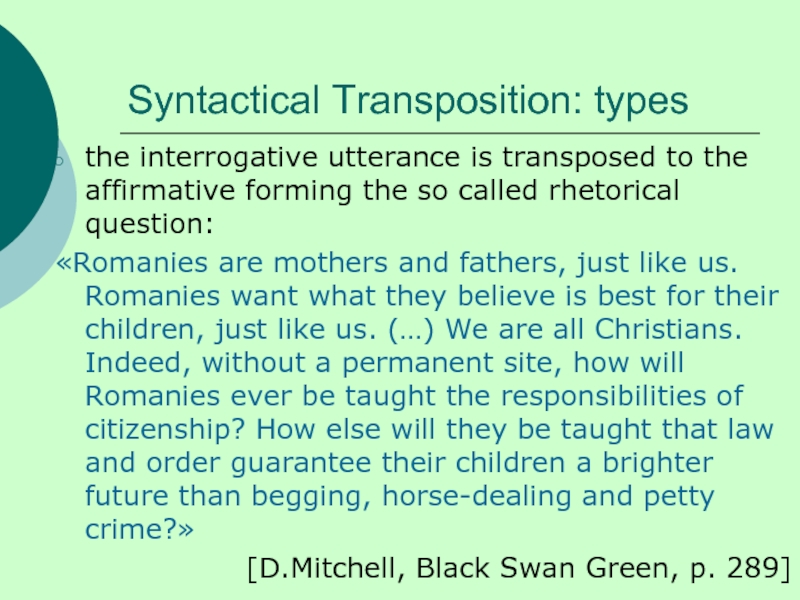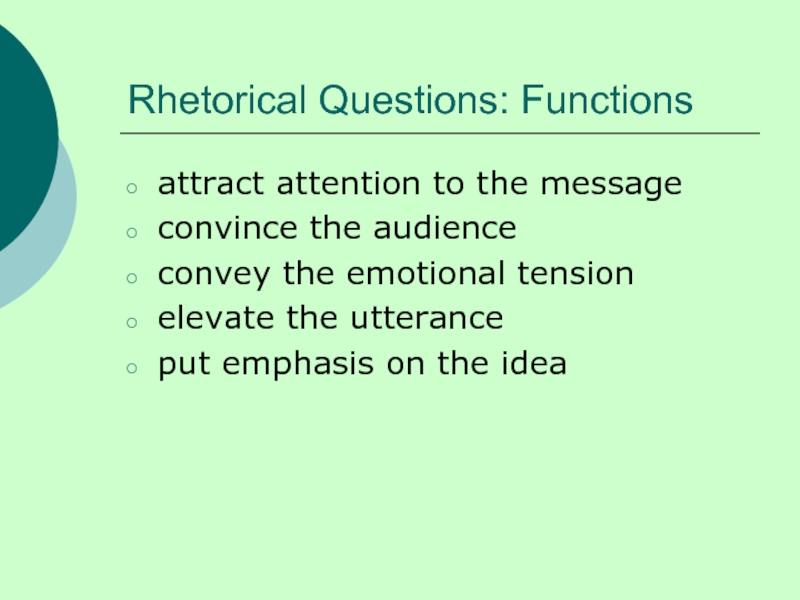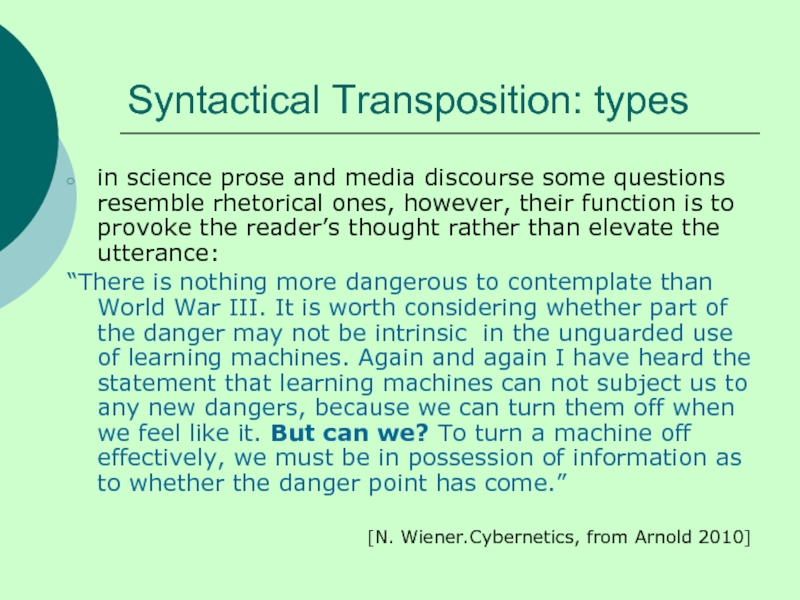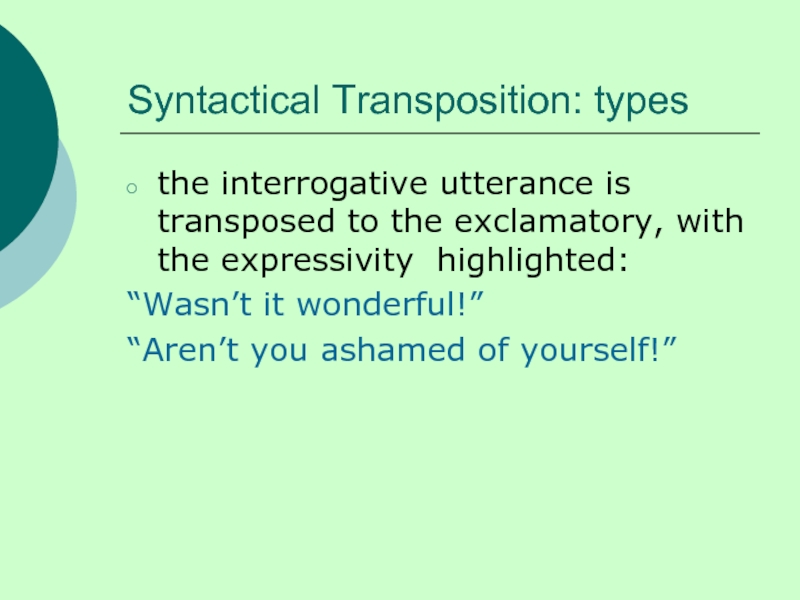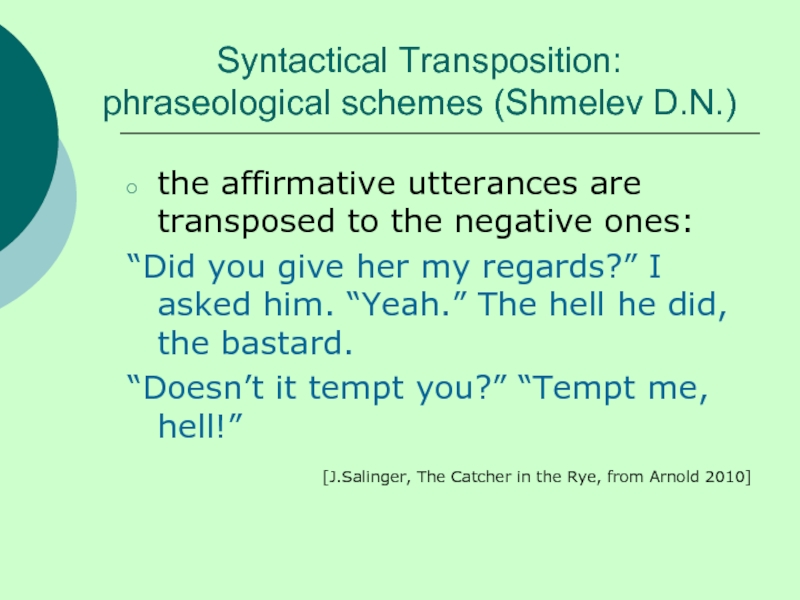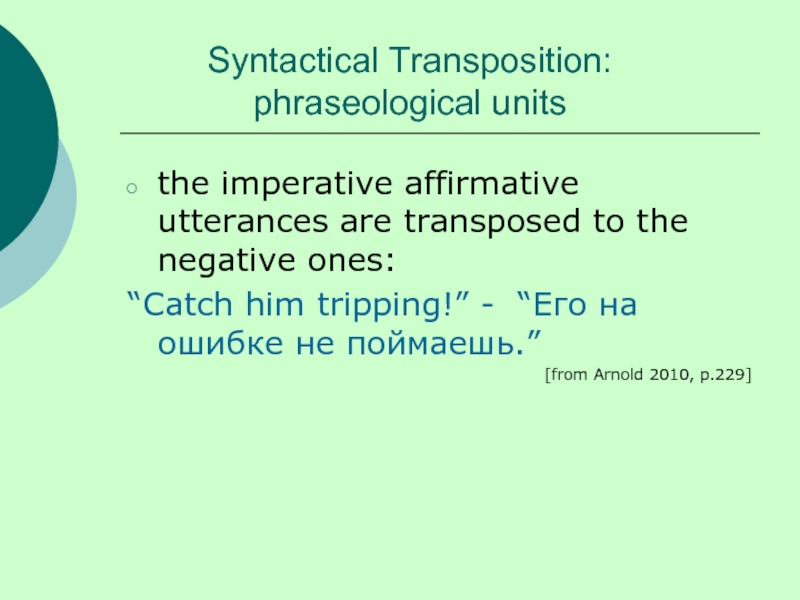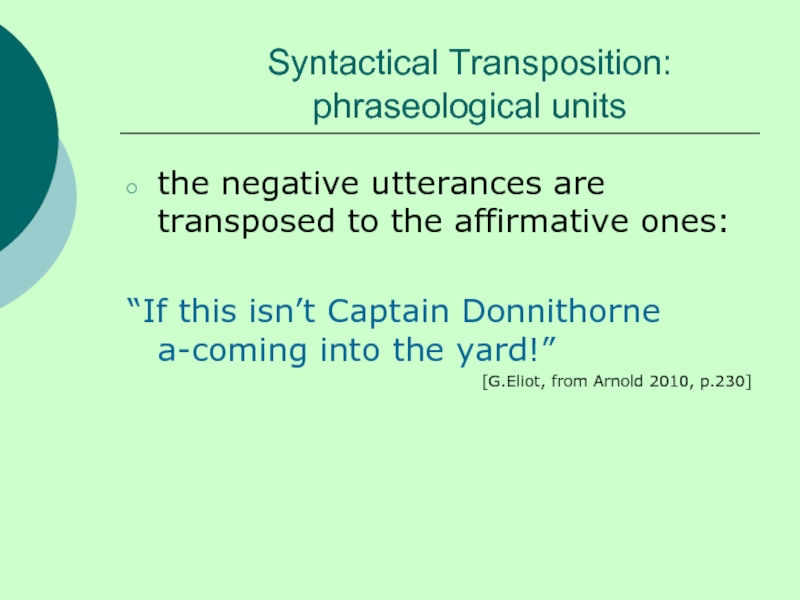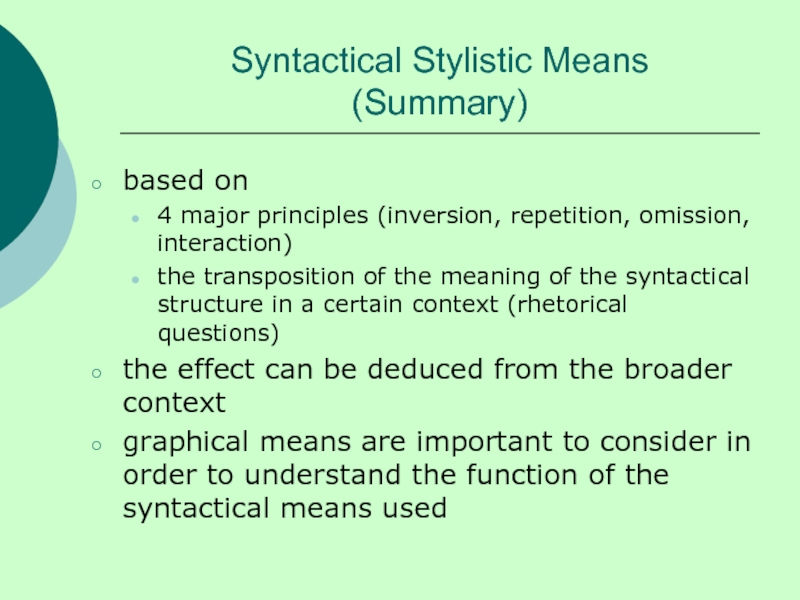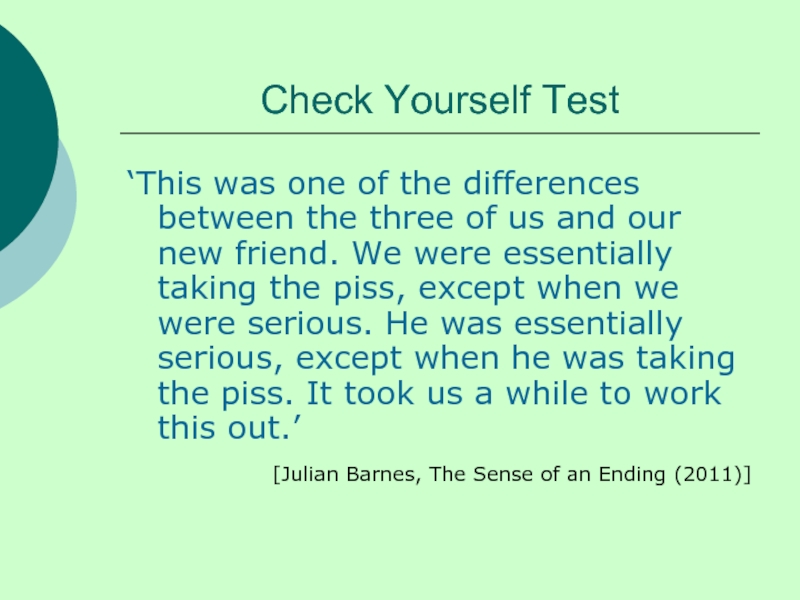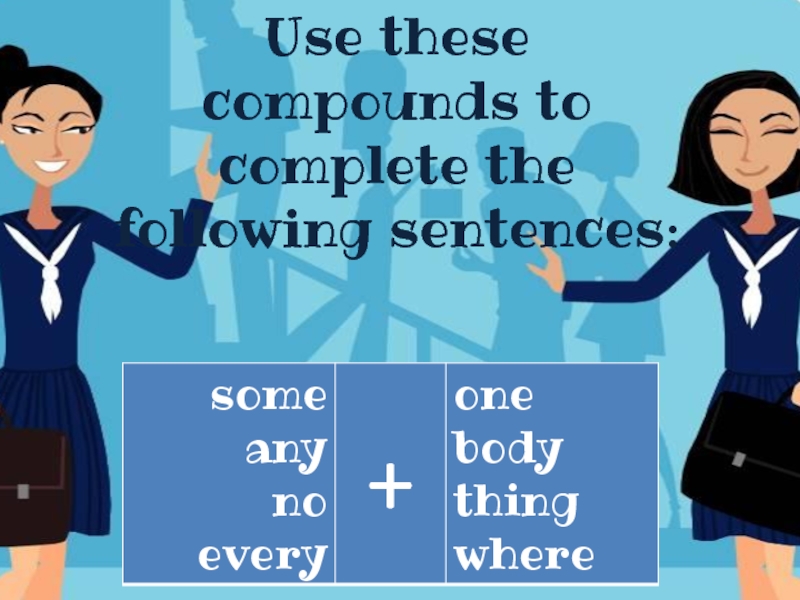- Главная
- Разное
- Дизайн
- Бизнес и предпринимательство
- Аналитика
- Образование
- Развлечения
- Красота и здоровье
- Финансы
- Государство
- Путешествия
- Спорт
- Недвижимость
- Армия
- Графика
- Культурология
- Еда и кулинария
- Лингвистика
- Английский язык
- Астрономия
- Алгебра
- Биология
- География
- Детские презентации
- Информатика
- История
- Литература
- Маркетинг
- Математика
- Медицина
- Менеджмент
- Музыка
- МХК
- Немецкий язык
- ОБЖ
- Обществознание
- Окружающий мир
- Педагогика
- Русский язык
- Технология
- Физика
- Философия
- Химия
- Шаблоны, картинки для презентаций
- Экология
- Экономика
- Юриспруденция
Stylistics of the English Language 11.Outline презентация
Содержание
- 1. Stylistics of the English Language 11.Outline
- 2. Outline Syntactical Stylistic Means Major principles at
- 3. Zeugma a figure of speech in which a
- 4. Zeugma helps to produce a dramatic effect:
- 5. Zeugma lends an ironic/humorous twist to the
- 6. Zeugma adds vividness and conciseness to texts:
- 7. Detachment words, phrases or syntactical structures which
- 8. Detachment: Functions specifies and characterizes the details
- 9. Detachment : Functions intensifies the fact
- 10. Emphatic Constructions “do” as a predicate intensifier
- 11. Emphatic Constructions: Functions lend intensity or contrast
- 12. Task 1 Detachment, Zeugma, Emphatic Constructions ‘That
- 13. The principle of Interaction and The
- 14. Convergence (Stylistics) the co-occurrence at a point
- 15. Task 2 Convergence “Tell all the
- 16. Task 2 Convergence Analysis Message: the poetess
- 17. Convergence (Syntax) a group of several syntactic
- 18. Syntactical Transposition the phenomenon when
- 19. Syntactical Transposition: types the affirmative/declarative utterance is
- 20. Syntactical Transposition: types the interrogative utterance is
- 21. Syntactical Transposition: types tag questions often represent
- 22. Rhetorical Questions: Functions attract attention to the
- 23. Syntactical Transposition: types in science prose and
- 24. Syntactical Transposition: types the interrogative utterance is
- 25. Syntactical Transposition: phraseological schemes (Shmelev D.N.)
- 26. Syntactical Transposition: phraseological units the imperative
- 27. Syntactical Transposition: phraseological units the negative
- 28. Syntactical Stylistic Means (Summary) based on
- 29. Check Yourself Test Surgeons must be
- 30. Check Yourself Test ‘This was one of
- 31. Check Yourself Test “There were three of
- 32. Thank you for your attention
Слайд 1Stylistics of the English Language 11
Koroteeva
Valentina Vladimirovna,
valentina.shilova77@gmail.com
Слайд 2Outline
Syntactical Stylistic Means
Major principles at work on the sentence level:
Interaction –
Zeugma, Detachment, Emphatic Constructions
Interaction and Convergence
Syntactical “transposition”
Interaction and Convergence
Syntactical “transposition”
Слайд 3Zeugma
a figure of speech in which a word, usually a verb or
an adjective, applies to more than one noun, blending together grammatically and logically different ideas:
‘[They] covered themselves with dust and glory.’
[Mark Twain, The Adventures of Tom Sawyer]
‘[They] covered themselves with dust and glory.’
[Mark Twain, The Adventures of Tom Sawyer]
Слайд 4Zeugma
helps to produce a dramatic effect:
“Who sees with equal eye, as
God of all,
A hero perish, or a sparrow fall,
Atoms or systems into ruin hurled,
And now a bubble burst, and now a world.”
[Alexander Pope, Essay on Man ]
[Alexander Pope, Essay on Man ]
Слайд 5Zeugma
lends an ironic/humorous twist to the utterance:
“We were partners, not
soul mates, two separate people who happened to be sharing a menu and a life.”
[Amy Tan, The Hundred Secret Senses]
[Amy Tan, The Hundred Secret Senses]
Слайд 6Zeugma
adds vividness and conciseness to texts:
“She lowered her standards by
raising her glass,
Her courage, her eyes and his hopes.”
[Flanders and Swann, Have Some Madeira, M’Dear]
[Flanders and Swann, Have Some Madeira, M’Dear]
Слайд 7Detachment
words, phrases or syntactical structures which interrupt the main sentence without
affecting it:
‘In those days – up to the age of 23, in actual fact – he lived with his parents on Princedale Avenue, on the outskirts of Latham (about twenty minutes on foot from where he was living now, already well into his fifties).’
[Adam Thorpe, Glow (2005)]
marked phonetically (pauses) and set off by graphical means - brackets, dashes or commas
relatively independent of the sentence they are inserted in
‘In those days – up to the age of 23, in actual fact – he lived with his parents on Princedale Avenue, on the outskirts of Latham (about twenty minutes on foot from where he was living now, already well into his fifties).’
[Adam Thorpe, Glow (2005)]
marked phonetically (pauses) and set off by graphical means - brackets, dashes or commas
relatively independent of the sentence they are inserted in
Слайд 8Detachment: Functions
specifies and characterizes the details of the statement:
‘The whole point,
he thought, is that it’s related to pleasure which is incoherent
-- no, illogical. ’
[Adam Thorpe, Glow (2005)]
may have an evaluative meaning:
‘She was lovely: all of her – delightful.’
[Theodore Dreiser, The Financier (1912)]
[Adam Thorpe, Glow (2005)]
may have an evaluative meaning:
‘She was lovely: all of her – delightful.’
[Theodore Dreiser, The Financier (1912)]
Слайд 9Detachment : Functions
intensifies the fact contained in a message; gives it
a lively and palpable colouring:
‘And sometimes with the sensation a cat must feel when it purrs, he would become conscious that Megan's eyes -- those dew-gray eyes -- were fixed on him with a sort of lingering soft look.’
[John Galsworthy, The Forsyte Saga (1922)]
‘And sometimes with the sensation a cat must feel when it purrs, he would become conscious that Megan's eyes -- those dew-gray eyes -- were fixed on him with a sort of lingering soft look.’
[John Galsworthy, The Forsyte Saga (1922)]
Слайд 10Emphatic Constructions
“do” as a predicate intensifier
the subject intensifier - it is
smb/smth who/that +verb…:
“It is Glenn who was responsible for that.”
the object intensifier - it is (to) that/smth (there) that +subj+verb…:
“It is the work he did that attracted her.”
the adverbial intensifier - it is then that…/ it is by/with/through smth that…:
“It is through struggle that he achieved his goal.”
“It is Glenn who was responsible for that.”
the object intensifier - it is (to) that/smth (there) that +subj+verb…:
“It is the work he did that attracted her.”
the adverbial intensifier - it is then that…/ it is by/with/through smth that…:
“It is through struggle that he achieved his goal.”
Слайд 11Emphatic Constructions: Functions
lend intensity or contrast to a certain part of
the sentence
give an emotive charge to the utterance
give an emotive charge to the utterance
Слайд 12Task 1 Detachment, Zeugma, Emphatic Constructions
‘That evening it was Dave who
read to the boys their bed-time story.’ [D.Carter]
‘ It was when my brother P.G.Pig was born that my mother broke her own rule.’ [Hilary Mantel, Destroyed (2003)]
‘It is the night-time that I like best. After 8:00 I know where he is, I know my father is safe.’ [Kate Pullinger, My Mother, My Father, and Me (1997)]
He easily made money and friends.
“Night came. I was a good child and an ambitious one, and I did what I was told, though when I was sleepy the prayers and the times tables got mixed up. Three sevens are twenty one. Hail, holy queen, mother of mercy. Four sevens are twenty eight. Hail our life, our sweetness and our hope. Five sevens are thirty-five. To thee do we cry, poor banished children of Eve, mourning and weeping in this vale (юдоль, долина) of tears.” [H.Mantel, EWL, 87]
‘ It was when my brother P.G.Pig was born that my mother broke her own rule.’ [Hilary Mantel, Destroyed (2003)]
‘It is the night-time that I like best. After 8:00 I know where he is, I know my father is safe.’ [Kate Pullinger, My Mother, My Father, and Me (1997)]
He easily made money and friends.
“Night came. I was a good child and an ambitious one, and I did what I was told, though when I was sleepy the prayers and the times tables got mixed up. Three sevens are twenty one. Hail, holy queen, mother of mercy. Four sevens are twenty eight. Hail our life, our sweetness and our hope. Five sevens are thirty-five. To thee do we cry, poor banished children of Eve, mourning and weeping in this vale (юдоль, долина) of tears.” [H.Mantel, EWL, 87]
Слайд 13The principle of Interaction
and
The technique of Convergence
interaction is a general
principle
convergence is a particular stylistic technique within the branch of decoding stylistic
convergence is a particular stylistic technique within the branch of decoding stylistic
Слайд 14Convergence (Stylistics)
the co-occurrence at a point in a text of a
cluster of several stylistic devices in order to foreground a particular idea or produce a desirable effect
the term was first used by Michael Riffaterre (1924-2006)
the term was first used by Michael Riffaterre (1924-2006)
Слайд 15Task 2 Convergence
“Tell all the Truth, but tell it slant
(oblique, sloping) –
Success in Circuit lies
Too bright for our infirm Delight
The Truth’s superb surprise”
[Emily Dickinson (1830-1886), American poet,]
Success in Circuit lies
Too bright for our infirm Delight
The Truth’s superb surprise”
[Emily Dickinson (1830-1886), American poet,]
Слайд 16Task 2 Convergence Analysis
Message: the poetess is being ironic about the
imperfect human nature desiring the truth on the one hand and being unable to bear it on the other
Phonographical level: in order to endow the verse with philosophical-existential sense, the poetess uses unconventional punctuation – no commas or periods; capitalisation - the purpose of emphasis; t- and s-alliteration and consonance
Lexico-semantic level: the idea of completeness of feeling (all the Truth, too bright, delight, superb) is juxtaposed with the idea of lack of something (slant, infirm); the use of contextual antonyms (INFIRM delight – SUPERB surprise) to highlight the incapacity of humans to encompass the Truth’s superbness; Truth is personified to be placed on a level with humans (the Truth’s surprise);
Grammatical level: elliptical construction – to foreground the main idea (“too bright for our delight… surprise”); semi-marked structure in the parallel first line (anaphora) - tell all the truth, but tell it SLANT (an adjective is used instead of an adverb)
Phonographical level: in order to endow the verse with philosophical-existential sense, the poetess uses unconventional punctuation – no commas or periods; capitalisation - the purpose of emphasis; t- and s-alliteration and consonance
Lexico-semantic level: the idea of completeness of feeling (all the Truth, too bright, delight, superb) is juxtaposed with the idea of lack of something (slant, infirm); the use of contextual antonyms (INFIRM delight – SUPERB surprise) to highlight the incapacity of humans to encompass the Truth’s superbness; Truth is personified to be placed on a level with humans (the Truth’s surprise);
Grammatical level: elliptical construction – to foreground the main idea (“too bright for our delight… surprise”); semi-marked structure in the parallel first line (anaphora) - tell all the truth, but tell it SLANT (an adjective is used instead of an adverb)
Слайд 17Convergence (Syntax)
a group of several syntactic elements, having a similar function
in the sentence and united by one subordinating word or clause (ex., homogeneous parts of the sentence):
“In Alaskan igloos, in Swiss chalets, and Spanish casas, in tenements (a building divided into separate flats), palaces, split level ranch houses – every place in the world where men and children come home to sleep, or eat, or brag of their exploits, or plan excursions, or be comforted, housewives are concocting that comfort.”
[Arnold 2010, p.256]
“In Alaskan igloos, in Swiss chalets, and Spanish casas, in tenements (a building divided into separate flats), palaces, split level ranch houses – every place in the world where men and children come home to sleep, or eat, or brag of their exploits, or plan excursions, or be comforted, housewives are concocting that comfort.”
[Arnold 2010, p.256]
Слайд 18Syntactical Transposition
the phenomenon when the contextual meaning of the syntactical
structure contradicts the grammatical meaning of the structure in question is called syntactical transposition
[adapted from Arnold 2010]
[adapted from Arnold 2010]
Слайд 19Syntactical Transposition: types
the affirmative/declarative utterance is transposed to the interrogative, with
the connotation of surprise/doubt/disappointment rendered (common in everyday speech):
“Erica: I can't believe it. Julianne is insecure?
Tom: Sometimes a cigar is not just a cigar.
Erica: But why? I mean, she is so competent and she's so experienced.”
[Being Erica, a Canadian series, S04E02]
“Erica: I can't believe it. Julianne is insecure?
Tom: Sometimes a cigar is not just a cigar.
Erica: But why? I mean, she is so competent and she's so experienced.”
[Being Erica, a Canadian series, S04E02]
Слайд 20Syntactical Transposition: types
the interrogative utterance is transposed to the affirmative forming
the so called rhetorical question:
«Romanies are mothers and fathers, just like us. Romanies want what they believe is best for their children, just like us. (…) We are all Christians. Indeed, without a permanent site, how will Romanies ever be taught the responsibilities of citizenship? How else will they be taught that law and order guarantee their children a brighter future than begging, horse-dealing and petty crime?»
[D.Mitchell, Black Swan Green, p. 289]
«Romanies are mothers and fathers, just like us. Romanies want what they believe is best for their children, just like us. (…) We are all Christians. Indeed, without a permanent site, how will Romanies ever be taught the responsibilities of citizenship? How else will they be taught that law and order guarantee their children a brighter future than begging, horse-dealing and petty crime?»
[D.Mitchell, Black Swan Green, p. 289]
Слайд 21Syntactical Transposition: types
tag questions often represent rhetorical questions:
“Today we read a
stack of N-words from the dictionary, one by one. The Metro Gnome does make speaking easy, as easy as singing, but I can hardly carry one around with me, can I?”
[D.Mitchell, Black Swan Green, p. 37]
[D.Mitchell, Black Swan Green, p. 37]
Слайд 22Rhetorical Questions: Functions
attract attention to the message
convince the audience
convey the emotional
tension
elevate the utterance
put emphasis on the idea
elevate the utterance
put emphasis on the idea
Слайд 23Syntactical Transposition: types
in science prose and media discourse some questions resemble
rhetorical ones, however, their function is to provoke the reader’s thought rather than elevate the utterance:
“There is nothing more dangerous to contemplate than World War III. It is worth considering whether part of the danger may not be intrinsic in the unguarded use of learning machines. Again and again I have heard the statement that learning machines can not subject us to any new dangers, because we can turn them off when we feel like it. But can we? To turn a machine off effectively, we must be in possession of information as to whether the danger point has come.”
[N. Wiener.Cybernetics, from Arnold 2010]
“There is nothing more dangerous to contemplate than World War III. It is worth considering whether part of the danger may not be intrinsic in the unguarded use of learning machines. Again and again I have heard the statement that learning machines can not subject us to any new dangers, because we can turn them off when we feel like it. But can we? To turn a machine off effectively, we must be in possession of information as to whether the danger point has come.”
[N. Wiener.Cybernetics, from Arnold 2010]
Слайд 24Syntactical Transposition: types
the interrogative utterance is transposed to the exclamatory, with
the expressivity highlighted:
“Wasn’t it wonderful!”
“Aren’t you ashamed of yourself!”
“Wasn’t it wonderful!”
“Aren’t you ashamed of yourself!”
Слайд 25Syntactical Transposition:
phraseological schemes (Shmelev D.N.)
the affirmative utterances are transposed to
the negative ones:
“Did you give her my regards?” I asked him. “Yeah.” The hell he did, the bastard.
“Doesn’t it tempt you?” “Tempt me, hell!”
[J.Salinger, The Catcher in the Rye, from Arnold 2010]
“Did you give her my regards?” I asked him. “Yeah.” The hell he did, the bastard.
“Doesn’t it tempt you?” “Tempt me, hell!”
[J.Salinger, The Catcher in the Rye, from Arnold 2010]
Слайд 26Syntactical Transposition:
phraseological units
the imperative affirmative utterances are transposed to the
negative ones:
“Catch him tripping!” - “Его на ошибке не поймаешь.”
[from Arnold 2010, p.229]
“Catch him tripping!” - “Его на ошибке не поймаешь.”
[from Arnold 2010, p.229]
Слайд 27Syntactical Transposition:
phraseological units
the negative utterances are transposed to the affirmative
ones:
“If this isn’t Captain Donnithorne a-coming into the yard!”
[G.Eliot, from Arnold 2010, p.230]
“If this isn’t Captain Donnithorne a-coming into the yard!”
[G.Eliot, from Arnold 2010, p.230]
Слайд 28Syntactical Stylistic Means
(Summary)
based on
4 major principles (inversion, repetition, omission, interaction)
the
transposition of the meaning of the syntactical structure in a certain context (rhetorical questions)
the effect can be deduced from the broader context
graphical means are important to consider in order to understand the function of the syntactical means used
the effect can be deduced from the broader context
graphical means are important to consider in order to understand the function of the syntactical means used
Слайд 29Check Yourself Test
Surgeons must be very careful
When they take the knife!
Underneath
their fine incisions
Stirs the Culprit – Life!
[Emily Dickinson, American poet, (1830-1886) ]
Stirs the Culprit – Life!
[Emily Dickinson, American poet, (1830-1886) ]
Слайд 30Check Yourself Test
‘This was one of the differences between the three
of us and our new friend. We were essentially taking the piss, except when we were serious. He was essentially serious, except when he was taking the piss. It took us a while to work this out.’
[Julian Barnes, The Sense of an Ending (2011)]
[Julian Barnes, The Sense of an Ending (2011)]
Слайд 31Check Yourself Test
“There were three of us, and he now made
the fourth. We hadn’t expected to add to our tight number: cliques and pairings had happened long before, and we were already beginning to imagine our escape from school into life. His name was Adrian Finn, a tall, shy boy who initially kept his eyes down and his mind to himself. For the first day or two, we took little notice of him: at our school there was no welcoming ceremony, let alone its opposite, the punitive induction. We just registered his presence and waited.”
[Julian Barnes, The Sense of an Ending (2011)]
[Julian Barnes, The Sense of an Ending (2011)]

